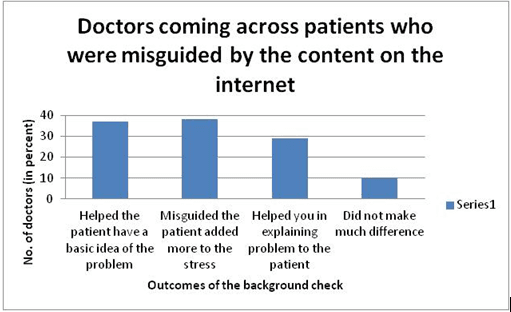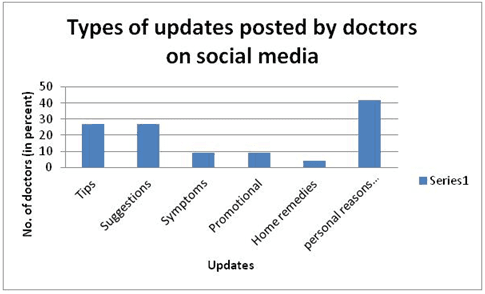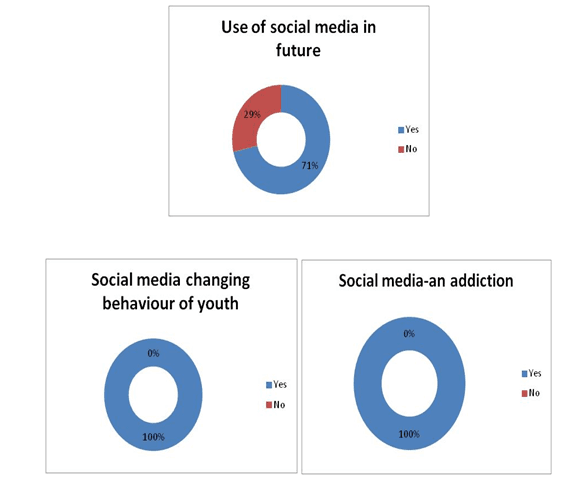
This research was done by students of TAPMI interning at echoVME – Digital Marketing Agency under the guidance of Team echoVME. Many thanks to Anubandh and Ravi Teja from T. A Pai Management Institute (TAPMI) for helping us complete this.
Key Indications from the Survey Done for Doctors:
The gender comparison: Female doctors used social media more for their personal purposes than their male counterparts. Though on an average, they spent less time on it- the difference in the average time between males and females was more than 15 minutes. However, they were more active in updating academic content and joining online forums.
Fresh and experienced doctors: It was easy for us to approach the fresh doctors or doctors with less experience to respond to this data than the senior doctors as the doctors with lesser experience had wider presence on Social Media or showed immense interest in the survey.
Social Media use: Channels which were most actively used by doctors were Facebook and WhatsApp, followed by Youtube, Twitter and LinkedIn. Facebook and Whatsapp were more popular amongst the doctors as majority of doctors use Social Media for their personal usage. However, we recommend doctors in India to be more active on LinkedIn as it is a great way to make international professional contacts and attain thought leadership landmark on the global map.
Doctor-patient interaction: When people across the globe look for a place to get medical treatment, they research on the web to find out the medical facilities. best suitable for their needs. They will only be aware of medical facilities in India, once there is sufficient and validated content on the internet. LinkedIn can perform as an important tool in this regards. It is a very strong interface to develop thought leadership and have professional interactions and debates.
Academic interaction: Not only connecting with patients, but social media play an important role in developing thought leadership and becoming the host to medical debates and discussion amongst the doctors, professors and people of high academics.
Social Media & misleading content: 94% of the doctors said that they found patients, who did background check of their problems online before consulting them. And nearly two-third of the total doctors met patients, who were misguided by the information given on the net about healthcare and about their own health issues. Still, 60% of doctors don’t share their research work or their successful cases online. There are only 29% doctors who use LinkedIn frequently. Things are even worse for Slideshare, where only 5% of doctors use it on a daily basis. Slideshare is one of those websites that have the potential to change the way people are educated in India. It can be extremely helpful in sharing information in the form of videos, Powerpoint presentations and Pdfs. It can make available the most innovate pedagogies used around the world to common man’s desk. Also, the Indian doctors who participated in this survey didn’t have blogs – which plays a crucial role in contributing content and achieve visibility and credibility for their personal brand using search engines. On one side doctors are coming across content on internet which is misguiding and on the other side they don’t use Social Media much to interact with patients or contribute content through the blogs – which is very important.
METHODOLOGY OF RESEARCH:
200 Doctors were asked to fill the survey and answer the questions that enquire about their activeness on social media. It was a type of exploratory research that aimed at how doctors use social media and how they realize its presence in their day-to-day activities.
INTRODUCTION
With the advent of technology, the world has come a long way for us. One of the major precursors of this change has been the internet. At the turn of the millennium, when some people were thinking, “that’s it! we cannot go further; world wide web is the coolest thing we can achieve”, the internet was undergoing a major change. The search engines were getting overhauled with the introduction of new ways of communication, and names like Orkut and MySpace were becoming common.
But time, tide and software coders wait for none. And soon the developers came up with ideas to further enrich our social media experience, in the form of Facebook, Youtube, LinkedIn and Twitter. Google+, Instagram and Pinterest have further added spice to the potpourri and social media has become an essential part of our personal and professional life and our daily endeavours.
When so much has changed around us and we are using social media for every and anything in our life, we thought why not sneak in to the life of doctors (with their permission, of course) and see how they use social media for their daily activities.
As a part of our research methodology, we conducted a survey with a sample size of 200 doctors and studied about their awareness and usage of social media for their personal and professional interactions. We categorised these doctors on the basis of age, gender, years of experience, type of work they are in, blogging habits and their experience so far with the social networking channels.
A major finding during the project was that out of the total responses, 100% of people were aware about social media websites. Out of which, 93% had their accounts on social media, which is very encouraging.
34% of survey takers were females. We found that 92% of females used social media to connect with family and friends, while 80% of males belonged to this category. 63% of females used social media for 30 minutes to 1 hour. Average time spent by females online was 58.5 minutes, while for males it was 74.5 minutes. When it came to participating in online forums or updating research work, males and females were equally active with 66% females and 64% males for online forums and 42% females and 40% males for updating research work. Also, 45% females update their successful cases online, while in case of males it’s only 39%.
The profile of the survey takers: It is an integral part of the survey as to what is the profile of the survey takers. Some of the important features of a survey taker’s profile could be the age group to which she or he belongs, the gender, the number of years of experience, the type of work they do and, if they are aware about the social media or not.

Awareness about social media: This is perhaps the most surprising data that we got. 100%, yes! 100% of people were aware about social media. Even though 7% did not have account, but they had heard about Facebook, Twitter, LinkedIn etc.
Meeting the right kind
During our survey, we mainly tried to approach people who were online, had email ids etc. As a result, we found almost everyone who was aware of the social media. There were very few people, who did not have an account on any of the social networking websites.
So, as per the data 94% of people had accounts on at least one of the social media websites. There were only 6% people who, even though aware, did not have an account.
We divided the survey into two parts. The First part that dealt with doctors who are present on social media is as follows:
Part I: Doctors who use social media
Why should we use social media? What purpose does it solve? Social media has more often been perceived as a ‘just-for-fun’ interface. But the smarty pants of the hyperspace found new and, I would say the apt ways for using the virtual podium. They used it for personal branding, they used it for promoting their brands and business ideas, they used it to differentiate themselves or their products from the rest, and they used it to generate thought leadership in their respective areas of interest. Now, the question arises how doctors use social media? On the basis of our survey, we found the following percentages.

It is also always important to quantify the parameters. We thus, attempted to find out how much time do doctors spend for the reasons mentioned above. We learnt that around 50% of doctors present on social media used it for a duration of half an hour to an hour. While the doctors in the second category i.e. 1 to 3 hours were 33%, which is pretty decent. Had the media been used more for professional purposes, more number of doctors would have belonged to the >3 hours category.

We further improvised on the last question to understand how much social media as an aid has helped them. It was encouraging to see that 85% of people believe that social media helped them greatly in their endeavours.
Expanding world of social media
Very quickly, new social media platforms are adding up to the network, which cater to our niche requirements. There is Pinterest, where you can pin photos of whatever you wish for, and then there is Quora, where you can get answers to your questions on the different topics you like. It will, however, take some time before these websites register their presence. In the meanwhile, we tried to find out how frequently, on a day-to-day basis, doctors visit some of the websites, which according to us are the most important ones in the digital community. The results are as follows:-
Amongst all the platforms, this tool has 74% of day-to-day users. The strongest one in social media, which has redefined the way we communicated in our circle. It’s Whats App
One of the most important questions on this survey is how many doctors interact with their patients on social media. This question is probably the epicenter of this research, as it defines the scope of social media for the people in the medical profession. The data shows how a major chunk of doctors don’t interact with their patients online.

Content on social media:
Internet has often been criticized for being an open platform, where any amateur can upload misleading content about something and claim to be the pundit of that field. If a person is not aware about this dubious characteristic of the cyberspace, he could very easily become a victim to it- we called it, the cybernoise. However, there are ways with which, we can improve the content quality, make the data more authentic and guide people in the right direction, towards the correct information.
As a part of our study, we tried to count the number of doctors who came across patients that read some misguiding material about healthcare on the internet, or who were misguided about their own health condition due to some flawed content present online. The stats are interesting.

Content Improvement:
Blogs: At first it was called ‘weblog’, but after it gained popularity, some people rephrased it as ‘we blog’. Blogging is one of the most important tools of the digital world. Blogs don’t have an expiry date. They stay there on the search engine and educate people, even if they were written a long time ago. We therefore, included questions about blogging in our survey and we have the following results:-

Online Forums: This is another way to participate in the online activities; you become a member of the online forum related to your interest, and take part in the discussions there or enlighten the non-professionals on several issues. These forums increase the credibility of the internet, as the information floated or issues discussed here are by experts. More active participation by doctors here means more quality content online.

Patients interacting with the online content and its impact: Looks like the patients have become smarter these days, and more cautious about their health. 94% doctors had come across patients who did a background check about their health problem before coming to them. This could also be an indicator of how fruitful a doctor’s presence on online forums could turn out to be for the lay persons present there.

When we asked doctors about what was the impact of this check, there were mixed responses.

Use of Whats App for communication with patients: Above we have mentioned that 74% of doctors used Whats App frequently on a day-to-day basis. On reply to how many doctors use it to communicate with patients, we only found 35% of them practicing so, which infers that 65% use Whats App only for their personal purposes like connecting with family, friends etc.
What doctors upload on social media: With cyberspace, we have (or should have) a symbiotic relationship. We consult the internet for ‘n’ number of things, and those things ultimately come from us. Doctors are undoubtedly, one of the most important resource to enrich the content present here. The enrichment could be in the form of tips, home remedies, current updates about drugs, summary of important health conventions that happen across the world, or it could be their research work that they have worked upon in the past. We, therefore, attempted to find out what are the things that doctors update most on the digital medium. We noted that nearly 43% of doctors use social media for their personal reasons only, and don’t post any medical information as such.

The Climax- what doctors think about social media’s role in our life: An overwhelming 92% of doctors believe that social media is a great tool to communicate with friends and colleagues. Now this, is very uplifting. However, a large population also feel that their patients are getting addicted to it.

Part II: Why doctors don’t use social media?
We wanted to know why some doctors stay away from social media. We found that around 90% of them believe that social media is not at all a waste of time. The question is, why are they then not riding on the superhighway?

Reasons!
- Not educated to use social media: Two-third of the doctors who don’t use social media are actually not educated enough to use it.

- Social media not important right now: Some doctors feel that they don’t need social media at present. There is, however, a 50-50 division amongst the two sides- those who consider its importance, and those who don’t.
- They encountered people who were misguided by social media about their health condition: This was another most striking feature of this survey.

- Patients running background checks of their problems on the web, before consulting: Majority of doctors met patients who did a background check of their problem on the internet before consulting them. Some of the doctors felt that such a background check misguided the patients and increased the stress.

Future prospects of social media
71% doctors said that they will use social media in future. All of them believed that it is changing the behaviour of youths and its addictive. This shows that all of them consider that social media is an influential tool and can make a strong impact on the people, especially youngsters, if used wisely.

Major inferences:
These are some of the major inferences that we have drawn by analyzing the survey data-
- Social media helped a lot-presence on social media: We observed that most of the people who said that social media has helped them a lot, were a day-to-day user of Facebook, Twitter, Youtube and Whats App. Awareness about LinkedIn was comparatively less as compared to the other four channels. Also, most of them were a part of some online forum or club. Naturally, 100% of them endorsed social media as a great tool to communicate and keep in touch with your friends and colleagues.

- Out of all the social media channels mentioned in the survey, Facebook is most popular among people with 86% of active users. Twitter ranks second with 46%, which is almost half of that of Facebook. LinkedIn has third rank with 40% users, while Google+ is just below LinkedIn with 37% active members. The fourth rank of Google+ and its closeness with the LinkedIn stats clearly shows how underrated this site is. LinkedIn ranks low, because it is mainly used for professional purposes and people don’t spend much time on it. However, Google+ is used for all the purposes; yet, its nowhere close to Facebook or Twitter.
- Slideshare is at fifth rank with only 28% frequent users. Slideshare is used basically for sharing powerpoint presentations (Ppts), videos and Pdfs, which is a major reason why number of active users are less. Youtube, the website which is the biggest hub of online videos, source of informative content, and one of the biggest online entertainment provider has 79% of day-to-day users.
And finally Whats App, which is a mobile app and stands out of the league of all the other website, has an enormous user base of 79% people, who use it on a frequent basis.

This research was done by students of TAPMI interning at echoVME – Digital Marketing Agency under the guidance of Team echoVME. Many thanks to Anubandh and Ravi Teja from T. A Pai Management Institute (TAPMI)





